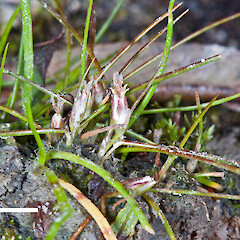Isolepis basilaris
Common name
pygmy clubrush
Synonyms
Scirpus basilaris (Hook.f.) C.B.Clarke, Isolepis novae-zelandiae Colenso
Family
Cyperaceae
Flora category
Vascular – Native
Endemic taxon
Yes
Endemic genus
No
Endemic family
No
Structural class
Sedges
NVS code
The National Vegetation Survey (NVS) Databank is a physical archive and electronic databank containing records of over 94,000 vegetation survey plots - including data from over 19,000 permanent plots. NVS maintains a standard set of species code abbreviations that correspond to standard scientific plant names from the Ngä Tipu o Aotearoa - New Zealand Plants database.
ISOBAS
Current conservation status
The conservation status of all known New Zealand vascular plant taxa at the rank of species and below were reassessed in 2017 using the New Zealand Threat Classification System (NZTCS) – more information about this can be found on the NZTCS website. This report includes a statistical summary and brief notes on changes since 2012 and replaces all previous NZTCS lists for vascular plants.
Please note, threat classifications are often suggested by authors when publications fall between NZTCS assessment periods – an interim threat classification status has not been assessed by the NZTCS panel.
- Conservation status of New Zealand indigenous vascular plants, 2017 . 2018. Peter J. de Lange, Jeremy R. Rolfe, John W. Barkla, Shannel P. Courtney, Paul D. Champion, Leon R. Perrie, Sarah M. Beadel, Kerry A. Ford, Ilse Breitwieser, Ines Schönberger, Rowan Hindmarsh-Walls, Peter B. Heenan and Kate Ladley. Department of Conservation. Source: NZTCS and licensed by DOC for reuse under the Creative Commons Attribution 4.0 International licence.
2017 | At Risk – Declining | Qualifiers: EF, RR, Sp
Previous conservation statuses
2012 | Threatened – Nationally Vulnerable | Qualifiers: EF, RR, Sp
2009 | Threatened – Nationally Endangered | Qualifiers: De
2004 | Serious Decline
Distribution
Endemic. North Island and South Island from Hawke’s Bay to Southland.
Habitat
Coastal, lowland to upland habitats, up to 700 m a.s.l. On damp, sandy or silty margins of lagoons, tarns, ephemeral lakes and rivers, freshwater or brackish.
Wetland plant indicator status rating
Information derived from the revised national wetland plant list prepared to assist councils in delineating and monitoring wetlands (Clarkson et al., 2021 Manaaki Whenua – Landcare Research Contract Report LC3975 for Hawke’s Bay Regional Council). The national plant list categorises plants by the extent to which they are found in wetlands and not ‘drylands’. The indicator status ratings are OBL (obligate wetland), FACW (facultative wetland), FAC (facultative), FACU (facultative upland), and UPL (obligate upland). If you have suggestions for the Wetland Indicator Status Rating, please contact: [Enable JavaScript to view protected content]
OBL: Obligate Wetland
Almost always is a hydrophyte, rarely in uplands (non-wetlands).
Detailed description
Minute, moss-like, densely tufted plant forming circular patches 10–100 mm diameter and up to 60 mm tall, bright green above, reddish brown below. Rhizome < 1 mm. diameter, much branched; sheathing bract at each node loose, membranous, with red nerves. Culms < 1.5 rarely up to 30 mm long, < 0.5 mm diameter. Leaves 1–2 on each branch, much > culms, 5–60 mm long, < 0.5 mm wide, setaceous, plano-convex; sheath membranous, red-nerved. Inflorescence an apparently lateral, single spikelet, or rarely 2, hidden among the leaves, pale green, occasionally with red markings; subtending bract leaf-like, channelled, very much > culm from which it arises and almost = leaves. Spikelets 2.5–3.5 × 1.5–2.0 mm, elliptical or oblong. Glumes 1–2 mm. long, ovate, elliptical, obtuse, white and membranous, or with patches of red on the sides; keel thick, green, occasionally slightly excurrent. Hypogynous bristles 0. Stamens 2–3. Style-branches 2–3. Nut c. 0.5 × 0.5 mm, c. ⅔ length of glume, obovoid to suborbicular, plano-convex, dorsally rounded, noticeably apiculate, red-brown to dark brown, almost black, surface often shining but distinctly reticulate.
Similar taxa
Isolepis caligenis. Isolepis basilaris has 1–2 leaves per tuft, very short flower stems with spikelets hidden amongst leaves and very dark brown nuts, flat on one side. Isolepis caligenis has 2–5 leaves per tuft, longer flower stems and pearly grey nuts, rounded on both sides. Occasionally Isolepis basilaris with elongated flower stems is difficult to distinguish from I. caligenis if fruit is immature.
Flowering
September–November
Fruiting
December–April (but seedheads long persistent)
Life cycle
Nuts are dispersed by water and possibly granivory and attachment (Thorsen et al., 2009).
Propagation technique
Easily grown from fresh seed and division of whole plants.
Threats
Domestic and feral cattle, sheep, horses and pigs are the serious threats throughout this species range, mainly through browse, trampling, and facilitating the spread of weeds. Competition from taller vegetation is significant at many sites. Coastal development (e.g., road widening) and erosion are further common threats to most populations. In some locations plants are threatened by 4-wheel drive vehicles.
Etymology
isolepis: From the Greek isos (equal) and lepis (scale)
basilaris: From Latin ‘basis’ borrowed originally from Greek, meaning basal
Where To Buy
Not commercially available but plants are held by several Botanic Gardens and specialist growers.
Attribution
Description adapted from Moore and Edgar (1970).
References and further reading
Johnson AT, Smith HA. 1986. Plant Names Simplified: Their pronunciation, derivation and meaning. Landsman Bookshop Ltd, Buckenhill, UK.
Moore LB, Edgar E. 1970. Flora of New Zealand, Volume II. Indigenous Tracheophyta: Monocotyledones except Gramineae. Government Printer, Wellington, NZ. 354 p.
Thorsen MJ, Dickinson KJM, Seddon PJ. 2009. Seed dispersal systems in the New Zealand flora. Perspectives in Plant Ecology, Evolution and Systematics 11: 285–309. https://doi.org/10.1016/j.ppees.2009.06.001.













